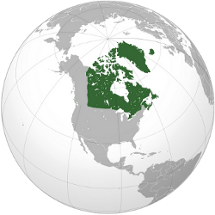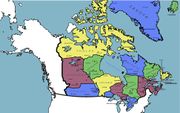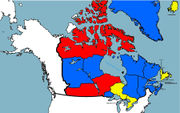The Republic of Canador
| This page is a work in progress by its author(s) and should not be considered final. |
| Og Republikk av Kånadørika The Republic of Canador
|
|||||
|---|---|---|---|---|---|
|
|||||
| Motto: "'Lev fritt eller dø!" "Live Free or Die!" |
|||||
| Anthem: "Etter frihet vi står" | |||||
Map of Canador
|
|||||
| Region | Altereal | ||||
| Capital | Fjåsklan | ||||
| Largest city | Winserville | ||||
| Official languages | None at federal level | ||||
| Recognised national languages | Canadorian, Icelandic, French, German, Inuita | ||||
| Demonym | Canadorian | ||||
| Government | Federal Constitutional Republic | ||||
| - | Head of State President |
Aritanya Lavisk (L) |
|||
| - | Vice President | Ottonan Sverin (L) | |||
| - | Speaker of the House | Antonakk Isiqquna (LA) | |||
| History | |||||
| - | Founding | 1771 | |||
| Area | |||||
| - | Total | 9.985 million km²d km2 3.855 million mile² sq mi |
|||
| - | Water (%) | 8.92% | |||
| Population | |||||
| - | 2010 estimate | 452,300,000 | |||
| - | Density | 55.4/km2 143.5/sq mi |
|||
| GDP (PPP) | 2013 estimate | ||||
| - | Total | NS$25.98 trillione | |||
| - | Per capita | NS$105,910 | |||
| GDP (nominal) | 2013 estimate | ||||
| - | Total | NS$25.2 Trillion | |||
| - | Per capita | NS$103,500 | |||
| Gini (2013) | 23.4 low |
||||
| HDI (2013) | 0.946 very high |
||||
| Currency | Veykå ( S^2) ($ŷ) |
||||
| Time zone | Western European Time Zone -Mountain Time Zonef (UTC(UTC+00:00)-(UTC-07:00)) | ||||
| Date format | dd ˘ mm ˘ yyyy | ||||
| Calling code | +1 | ||||
| Internet TLD | .ca, .cagov | ||||
The Republic of Canador (commonly reffered to as "East Canador") is a Federal Republic largely located in North America, with the island province of Fjakkraikae (Iceland) in Nothern Europe. It consists of 1 capital territory and 14 individual provinces, the largest of which being Såvoya (Greenland), and the most populous being Winser. Canador shares a border with several other nations: The Peoples Republic of West Canador to the west, United States of America to the south, and a maritime border with Treko and the The Democratic States of Europe to the east.
Canador has the strongest economy in Altereal, and is also the wealthiest of all nations in the region. The Canadorian Veykå is the most valuable currency in Altereal, having an exchange value exceeding that of $2 Ns. By total land area, it is the second largest nation in the region, only being surpassed by the Grand Russian Federation.
Contents
Etymology
The name "Kånadørika" [Canador] is taken from the Trekian region of "Kånadoria", in which the first settlers originated from. It first appears on maps in 1593, written as "Kånadorian". By the mid 17th century, The name was altered to its modern day form of Kånadørika. Though the origination of the word's change in spelling is unclear, a commonly held theory suggest that it stems from a misspelling of the word on a map from the era.
History
Pre Colonial
Early History
Being former colonies of Treko and Europe, the Canadorian provinces would go on to declare their independence on October 29th, 1746; before any other colonial possession in the Americas. The Colonies existed separately until January 3rd of 1771, when they were united together with the ratification of the
Post Independence
After unification, the Republic would slowly undergo a period steady development and growth. The first several presidents advocated a policy known as the "Neutral association theory", in which the nation would keep out of international affairs and politics in favor of internal stabilization and operation.
The war of independence between the colonies on the west coast and their Russian possessors (The War of 1832) would result in a colonial victory. The now independent colonies requested acceptance into the Union, which was accepted in 1834. They would be reformed by the government into the "Pacific Territories", however provincehood would be granted by the late 19th century.
Developments in technology and manufacturing quickly spread from Europe to Canador, forever changing the lifestyle from rural farmers to urban dwellers. The cities sprang up in the east along various ports, becoming established centers of trade and commerce. Canador was surprisingly slow to industrialize beyond the east coast, however by the 1870s, industrialization would come to shape west coast as well in the form of steel plants and heavy mining. A transcontinental railroad would be completed in 1876. Linking the east and west coasts, the railroad would become a decisive factor in the growth and development of the west. The Pacific Territories would be divided into four provinces two years later.
Modern History
By the late 19th century, the nation has experienced over 100 years of separation from international affairs. The annexation of
Polynesia and Savoyå Island in 1903 and 1907 respectfully would reverse this long period is isolationism. Increased trade with Canador's southern neighbor, the United States of America and England, ushered in new ideas and riches into the Republic. By 1910, Canador would become involved in international trade. Trade routes were established from ports in Asia and Europe. These routes would not only serve commercial uses, but would be traveled by thousands of immigrants looking to call Canador home.
Throughout the opening stages of the First World War, Canador insisted on taking an isolationist approach to the global conflict. While the rest of the world fought in the Great War, Canador retained its neutrality and did not participate.
Following the aftermath of the First World War, Canador entered a period of economic prosperity and affluence. The nation emerged from the war as a young world power, and its economy boomed with the stock market. Millionaires were made out of clever entrepreneurs who invested in soaring stocks. The 1920's are seen as the creation of a modern Canador. Technological innovations such as the automobile, radio, and the skyscraper would come to dominate the lives of not only the wealthy, but the middle class as well. Electrification linked the rural west to the power grid, vastly improving the lives of agrarian citizens. Winserville became a global center for trade and culture, with it and other major cities being the centers of a massive trend in urbanization.
The glories and riches of the 1920's would come to a screeching halt with the crash of the stock market on October 29th of 1929Depression impacted Canador was able to withstand political dissent long enough to avoid the reformations that brought authoritarian regimes to countries across the world. When the Second World War came into existence, Canador claimed neutrality, and distanced itself from the battles in Europe and Asia.
As the world entered the post war period, Canador retained neutrality. Despite being the bastion of global Capitalism, Canador refused to combat Communism., Domestic life in the post war period saw a revival to the attitudes and innovations of the 1920's. The stock market once again powered the economic superpower into prosperity. New attitudes and urban trends led to the suburbanization of locales around major cities, causing the population to migrate into the newly built suburban cities. The 1950's saw the rise of television, a powerful new tool that launched the nation into a consumerist frenzy of advertising and shopping sprees.
Contemporary Era
In the later decades of the 20th century, Canadorian life was for the most part subject to a steady period of economic security. The middle class grew in size and strength, forever becoming the staple majority of the population. The far north was subject to increased financial interests, allowing for its development and population. Såvoya (Greenland) in particular became a global center of the oil industry, with its population increasing by 700% between 1970 and 1990.
In the 1990s, trade sanctions placed on Canador by Communist nations began negatively affecting the population of the west coast, which relied extensively on trade to fuel its economy. By 2000, the west was struggling to survive economically, and became politically separate from the east with its turning to left wing ideologies. The election of the communist Aleksandr Akoviqq as governor of the province of Leon proved to be a turning point in western Canador's political composition. Several other Communist and Marxist leaders were elected to high ranking positions in other provincial seats. By 2005, the wealth gap between the east and west grew so great that provinces on the west coast evoked the 7th Amendment of the Canadorian Constitution, officially declaring its independence from the Republic of Canador. A new nation of West Canador was established, placing Akoviqq as the leader of the Marxist-Leninist government.
Geography, Climate, and the Environment
Canador occupies most of North America, sharing land borders with the contiguous United States to the south (the longest border between two countries in the world) and the nation of West Canador to the west. Canador has a coast with the Atlantic Ocean in the east. To the north lies the Arctic Ocean. The province of Fjakkraikae is located in Europe. By total area (including its waters), Canador is the second-largest country in the world, after Russia.
Since the end of the last glacial period, Canador has consisted of eight distinct forest regions, including extensive boreal forest on the Canadorian Shield. Canador has around 31,700 large lakes, more than any other country, containing much of the world's fresh water. There are also fresh-water glaciers in the Canadorian Isakka Mountains and the Coast Mountains. Canador is geologically active, having many earthquakes and potentially active volcanoes.
Average winter and summer high temperatures across Canador vary from region to region. Winters can be harsh in many parts of the country, particularly in the interior and Prairie provinces, which experience a continental climate, where daily average temperatures are near −15 °C (5 °F), but can drop below −40 °C (−40 °F) with severe wind chills. In noncoastal regions, snow can cover the ground for almost six months of the year, while in parts of the north snow can persist year-round. Coastal Winser has a temperate climate, with a mild and rainy winter. On the east and west coasts, average high temperatures are generally in the low 20s °C (70s °F), while between the coasts, the average summer high temperature ranges from 25 to 30 °C (77 to 86 °F), with temperatures in some interior locations occasionally exceeding 40 °C (104 °F).
Wildlife
Government and Politics
Canador is a Constitutional Republic, with a government consisting of three branches; The Executive, Legislative and Judicial branches. The legislature of Canador is one of bicameral design, being split between an upper house (the Senate), which includes six senators from each province, and a lower house (House of the Provinces), which operates on a population basis.
An increasing percentage of Canadorians wish for the drafting of a new constitution to turn the nation into a Parliamentary Republic, though this is still not considered to be likely within the next decade.
The nation is often ranked as the most economically and civilly free nation in the world. The Canadorian Constitution is the basis of the country's libertarian ideology, as it specifically prevents the government from taking a domestic role other than the protection of its citizens extensive liberties. Canador has legalized various acts such as drug usage, homosexual marriage, abortion, firearms, and many other controversial freedoms that are subject to criticism in other nations. Libertarianism in Canador exists to such an extant, that the people have a constitutional right to over throw the government if it becomes destructive of the rights in the constitution. "Direct legislation or abolishment of the National Government may be instituted by the People if the government fails to acknowledge, infringes upon, or annuls the liberties granted in this constitution." (Amendment VII).
The libertarian ideology of Canador is seen by experts to be the primary reason of the struggling West's secession and independence in 2005.
Law Enforcement and Crime
Military
Canador has historically been a state of armed neutrality. The nation's military is built solely for the purpose of national defence. Nevertheless, it does operate strategic forces to attack hostile nations in the event of a homeland invasion. There are five branches of the Canadorian military; The Army (Wurkkså, Navy (Naviya), Airforce (Luftvåfen), Marine Corps (Marinn Keln), and Coast Guard ( Kosta Prøtektian)
Foreign Relations
Canador is considered to be one of the most established neutral states in Altereal. The nation's heavy Capitalist stance has often put it at odds with other Marxist nations including Juche Republics, Grand Soviet Union, Sjovenia, Iverik Empire, and most notably, the Peoples Republic of West Canador, a now totalitarian state which broke away from Canador and declared independence in 2005. Despite this, Canador does not engage in any hostilities, and is not a member of any international governmental organizations.
Provinces
Economy
Canador is the most economically powerful nation in Altereal. It is the headquarters of more Fortune 500 corporations than any other nation in the region. This is in part due to the Canadorian government's laissez faire approach to the economy, which creates a distinct separation between the affairs of the state and the market. Perhaps the epitome of Canadorian wealth and prosperity is the city of Winserville. Located on the east coast in the province of Winser, Winserville is a major center forDemographics
As of the 2010 census, the population of Canador is 452,300,000; an increase of 4.2% from the last census in 2006. The population is for the most part situated in the lower regions of the nation, though recent operations and job markets in the sub-arctic and arctic regions are attracting a considerable number of migrant peoples.
Population
Canador is populated by a diverse range of ethnicities and peoples.
- Caucasian: Caucasians form the largest ethnic group in Canador, accounting for about 76.7% of the nation's population. Most Caucasians originate from the three original European colonial possessors, Treko, DSE, and Europe, with Trekians (Scandinavians) accounting for 56.4% of the Caucasian population.
- Asian: Asians are the second largest racial group in Canador, forming 14.2% of the population. Many Asian-Canadorians can trace theie ancestry back to Oriental immigrants arriving in Canador in the late 19th century.
- Aboriginal: Aboriginals make up 4.3% of the population. The group include the various native cultures ranging from the Inuits to the tribes of the Southern Plains. Aboriginals have a large impact on Canadorian culture, especially in the far north, where there populations are the largest.
- Black: Blacks form 2.9% of the population. Many blacks emigrated from the United States in the early 20th century.
- Latin American: Latin Americans form 1.2% of the population. Many recent immigrants in Canador originate from Latin America.
Language
Culture
Canadorian culture is itself a melting pot of various ethnic traditions. While Canadorian is the national language, other languages including French, Norwegian, English, and Russian exist on a regional level. Historically speaking, Northern Canador is culturally Trekian (Norwegian), a reminiscence of the Trekian colonial era. The south is heavily influenced by the French, as this was the location of the European Colonies (Democratic States of Europe). The far east is ethnically Russian, for the former Russian colonies were located in the region. Inuit culture has a profound impact on daily life, providing the source for many place names and loanwords in the Canadorian language.
Infrastructure
Transportation
Roadways
An intricate system of highways connects cities in the Canadorian landmass, Savoyå, and Etinnannvik. The first highway to connect both coasts was Route 20, which spanned from Deyvion to Leon. Opened to the public in 1927, Route 20 would become a major roadway leading to the Canadorian west coast. Following the Second World War, the government invested in a series of interstate highway programs to thoroughly connect and provide quick and simple transportation between the provinces. Interstate 10 (1953) linked Winserville to Leon, almost fully replacing the usage of Route 20. As the years progressed, the interstate system grew in size and scope.
Air Transport
The civil airline industry is entirely privately owned, and is one of the largest airline industries in the world. As of 2014, the three largest Canadorian based airlines are; Luftdørika (Air Canador), Northern Airlines, and Canador Airways. The busiest airport in the nation is Charvåne International Airport, the principle airport serving the city of Winserville.
Railways
Like the airline industry, Canador's network of railroads is also privately owned. The first transcontinental railroad was completed in 1876 by the Atlantic Railways and Western Pacific corporations. Contemporary Canador is home to the world's largest high speed rail system, with high speed rail (HSR) lines connecting cities on the east coast and the south.
Energy
Production of electricity in Canador is a privately operated sector. Nuclear power contributes to the vast majority of the nations power generation, followed by coal, hydroelectric, and natural gas. In recent years, there has been an entirely private effort to reduce pollutants output in the nation, leading to a push for cleaner energy. Nuclear fusion is being researched and developed by scientists throughout the nation, it is not expected to become a viable energy source within the next decade.
| Name | Province | Population | |||
|---|---|---|---|---|---|
| Winserville | Winser | 21,300,000 | |||
| Seringlija Aeriksal | Seringlija | 8,605,950 | |||
| Equinea | Vispyasha | 5,144,540 | |||
| Sardaska | Dubbvostikkna | 5,010,300 | |||
| Ebtiere | Olkvolm | 4,700,000 | |||
| Marikas | Kingsland | 4,550,240 | |||
| Adaturnal | Olkvolm | 3,877,460 | |||
| Etinnaanvik | Fjakkraikae | 3,146,725 | |||
| Hannavieu | Karrera | 2,100,390 | |||
| Edistopol Grånja | Erinjaak | 2,090,000 | |||




